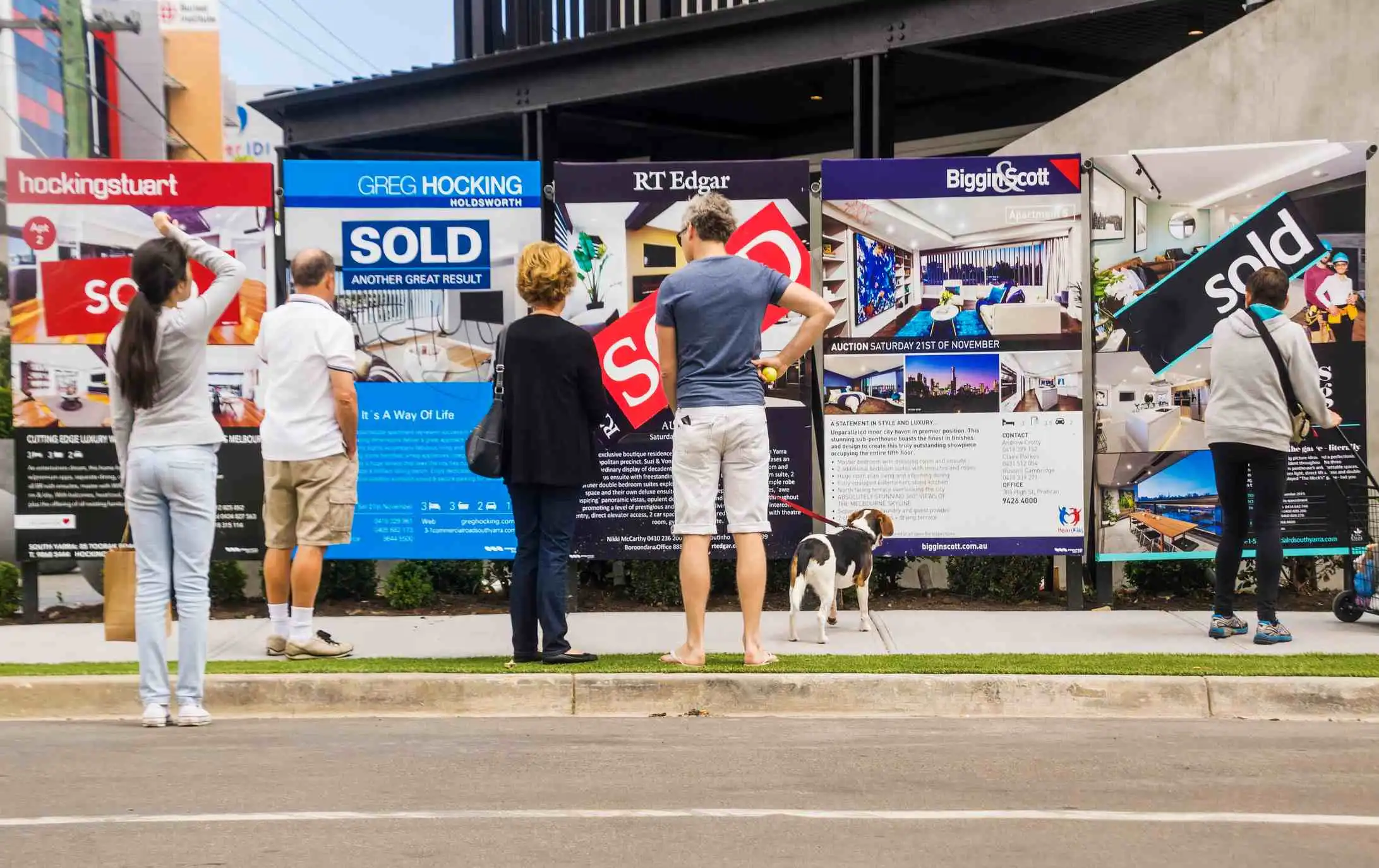'Short but sharp' housing decline picks up pace across Australia
Another month of interest rate hikes has dampened the Australian property market further over August, with price falls seen in all but one capital city and regional market.
CoreLogic's latest report paints a picture of an accelerating downturn, but finding the bottom could also happen relatively swiftly, meaning net gains over the pandemic period could still turn out to be substantial.
So what does it all mean for the imminent spring selling season and when will the market begin to rebound?
National property prices: August 2022
Houses$803,999Monthly change: -1.7%
Units$608,313Monthly change: -0.9%
August was another difficult month for Australian home values after a fourth consecutive rate hike from the RBA.
CoreLogic's report showed the median Australian property dropped -1.6 per cent to $738,321, the largest monthly decline since 1983.
| Market | Month | Quarter | Annual | Median Value |
|---|---|---|---|---|
| Sydney | -2.3% | -5.9% | -2.5% | $1,066,493 |
| Melbourne | -1.2% | -3.8% | -2.1% | $782,053 |
| Brisbane | -1.8% | -2.5% | 17.5% | $762,284 |
| Adelaide | -0.1% | 1.6% | 21.85 | $652,959 |
| Perth | -0.2% | 0.4% | 4.9% | $561,781 |
| Hobart | -1.7% | -3.3% | 5.8% | $714,370 |
| Darwin | 0.9% | 2.3% | 6.3% | $512,531 |
| Canberra | -1.7% | -2.6% | 7.8% | $909,748 |
| Combined capitals | -1.6% | -3.8% | 2.2% | $808,287 |
| Combined regional | -1.5% | -2.1% | 13.4% | $594,006 |
| Australia | -1.6% | -3.4% | 4.7% | $738,321 |
Sydney again took the biggest hit, falling by -2.3 per cent for the month, while Melbourne was down a milder -1.2 per cent. For perspective, Sydney home values rose +27.7 per cent over the pandemic and have now dropped -7.4 per cent since hitting that peak.
Brisbane's sudden decline has deepened, declining -1.8 per cent in August, though that needs to be considered in the context of the city's historic +42.7 per cent gains.
Adelaide's dream run also looks to be over as prices went fractionally into the negative for the first time in over two years.
The Perth market remained relatively flat, while Hobart and Canberra both experienced substantial falls of -1.7 per cent. Darwin was the only capital city to achieve growth for the month, getting a +0.9 per cent boost.
Regional markets have also weakened across the board, posting collective falls of -1.5 per cent with SA the only state to maintain positive growth.
Despite the magnitude of the drops, CoreLogic's research director Tim Lawless said that the significance of the correction phase "will really depend on how long this lasts, and the chances are it probably will be a fairly short but sharp downturn."
Listings are set to rise in the spring selling season
Looking to CoreLogic's listings data, it's been a more active winter than usual on the selling front. New listings over August were up +13.4 per cent compared to the same period in 2021 and +6.5 per cent higher than the five-year average.
Total available stock on the market remains low at -9.5 per cent below the five-year average, although that figure is creeping up now too.

The spring selling season will be a test for the market as listings increase, although this year could be slightly more subdued.
"Between winter and spring we typically see a 22 per cent rise in the number of new capital city listings based on the pre-COVID five-year average," Mr Lawless said.
"The flow of new listings this spring season may not be quite as active with the housing downturn dissuading some prospective vendors, but we are likely to see more listings added to the market than in winter."
Even so, more cautious buyer activity could mean a net increase in the total number of homes on the market, so buyers and sellers alike will be keeping a keen eye on how things progress over the warmer months.
Regional markets begin to synchronise with capital city downturns
The period of regional markets dominating capital cities looks to have run its course, with regional losses in August more or less reflecting what happened in the capitals.
| Market | Month | Quarter | Annual | Median Value |
|---|---|---|---|---|
| Regional NSW | -1.7% | -2.9% | 13.1% | $727,857 |
| Regional VIC | -1.3% | -2.1% | 9.9% | $584,823 |
| Regional QLD | -1.5% | -2.0% | 15.5% | $564,155 |
| Regional SA | 0.2% | 3.1% | 22.1% | $339,525 |
| Regional WA | -0.5% | -0.2% | 6.9% | $402,006 |
| Regional TAS | -1.7% | -2.2% | 13.9% | $525,653 |
| Combined capitals | -1.6% | -3.8% | 2.2% | $808,287 |
| Combined regional | -1.5% | -2.1% | 13.4% | $594,006 |
Regional SA was the only market to return any moderate growth, while most others fell into line with the kinds of declines being seen in the cities.
"The largest falls in regional home values are emanating from the commutable lifestyle hubs where housing values had surged prior to the recent rate hikes," Mr Lawless said.
"Over the past three months, values are down -8.0 per cent across the Richmond-Tweed, -4.8 per cent across the Southern Highlands-Shoalhaven market and -4.5 per cent across Queensland’s Sunshine Coast."
Again, these numbers need to be considered in the context of more than +40 per cent growth seen in regional Australia between March 2020 and January 2022, so net gains remain exceptionally high.
Price declines are still heavily outweighed by gains of the recent boom
When understanding the negative figures coming out of the property market right now, perspective is everything.
CoreLogic's report compares the trough-to-peak growth through the pandemic with the recent declines, and the numbers clearly show that the market would have to fall far further before those gains come close to being erased.
| Market | COVID throught to peak growth | Decline from peak | Month of market peak |
|---|---|---|---|
| Sydney | 27.7% | -7.4% | Jane 22 |
| Melbourne | 17.3% | -4.6% | Feb 22 |
| Brisbane | 42.7% | -2.6% | Jun 22 |
| Adelaide | 44.7% | 0.1% | Jul 22 |
| Perth | 25.9% | -0.2% | Jul 22 |
| Hobart | 37.7% | -3.3% | May 22 |
| Darwin | 31.1% | -10.1% | May 14 |
| ACT | 38.3% | -2.9% | Jun 22 |
| Regional NSW | 47.6% | -2.9% | May 22 |
| Regional VIC | 35.0% | -2.1% | May 22 |
| Regional QLD | 42.7% | -2.2% | Jun 22 |
| Regional SA | 42.9% | 0.0% | Aug 22 |
| Regional WA | 30.1% | -16.5% | Jun 08 |
| Regional TAS | 51.0% | -2.3% | Jun 22 |
| Combines capitals | 25.5% | -4.2% | Apr 22 |
| Combined regional | 41.6% | -2.2% | Jun 22 |
| Australia | 28.6% | -3.5% | Apr 22 |
Mr Lawless gave an example that "a 15 per cent peak to trough decline would roughly take CoreLogic’s combined capitals index back to March 2021 levels.
"Additionally, many homeowners would have had at least a 10 per cent deposit and paid down a portion of their principal, the risk of widespread negative equity remains low."
In terms of the value of their homes, the vast majority of sellers will be significantly better off even if a correction as large as -15 per cent does occur
What's next for the Australian property market?
Mr Lawless anticipates the market to continue cooling for the rest of 2022 and potentially into 2023, saying "it's hard to see housing prices stabilising until interest rates find a ceiling and consumer sentiment starts to improve."
Thankfully, it's looking like the RBA's swift rate increases are already having an impact, and the bulk of the hikes may already be over, suggesting that a genuine market crash is looking increasingly unlikely.
AMP Capital's Shane Oliver is predicting interest rates should peak around the 2.60 per cent mark in early 2023 and are very unlikely to stretch beyond 3 per cent due to the implications that would have for the housing market and widespread mortgage stress.
He, along with many other economists, is also forecasting a cut to interest rates later next year, so this could be a relatively limited period of downturn before things bounce back.
In the immediate future though, it could be a trickier spring than usual for sellers. "There is a good chance advertised stock levels will accumulate through the spring selling season, providing more choice for buyers and adding further downwards pressure on housing values," Mr Lawless explained.
"Sellers will need to be realistic in their pricing expectations and ensure they have a quality marketing campaign in place."
Getting an online estimate to better understand the current value of your home and speaking to a top local agent to learn how buyers are behaving in your suburb are two great ways to get a head start on the selling process.








